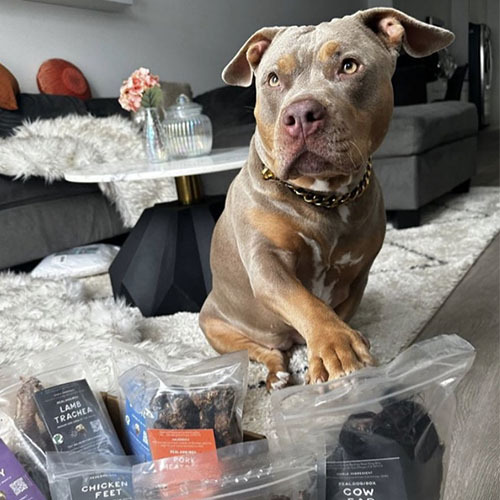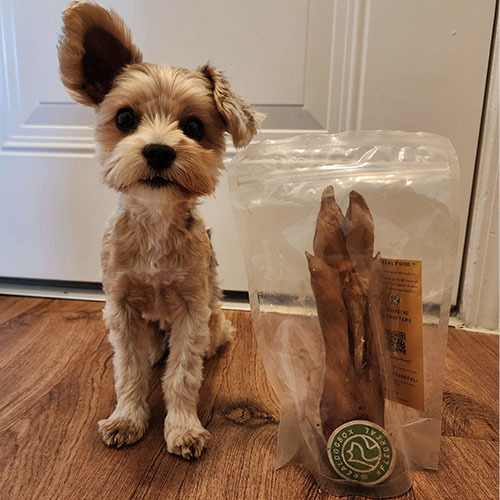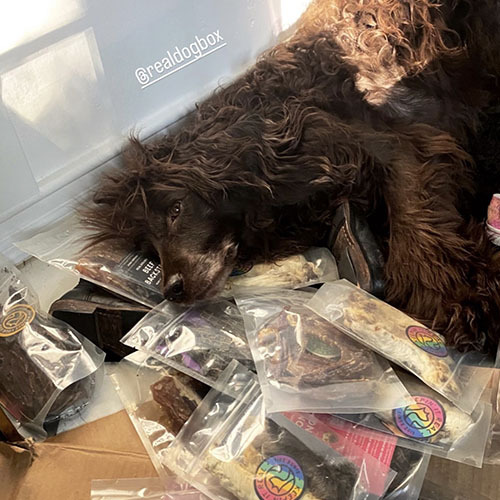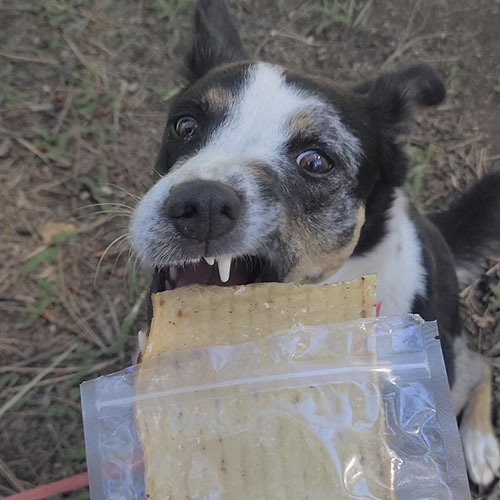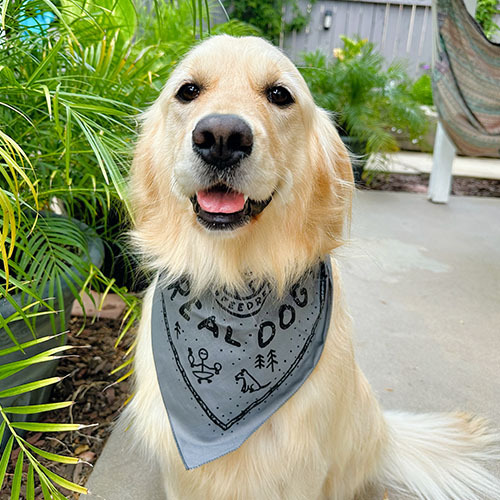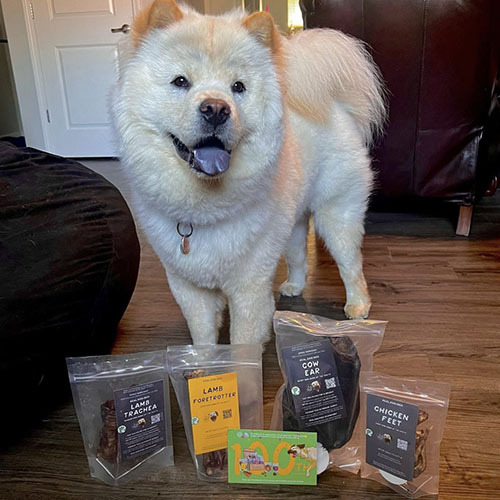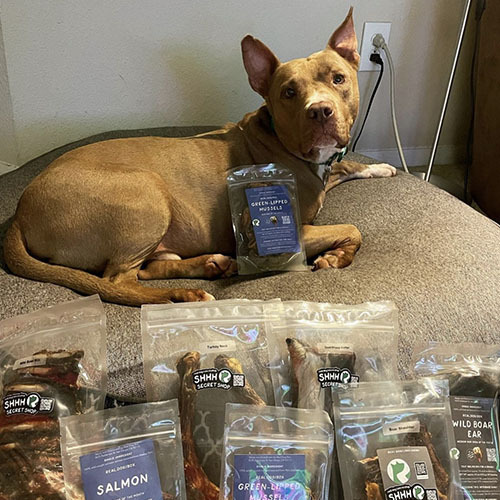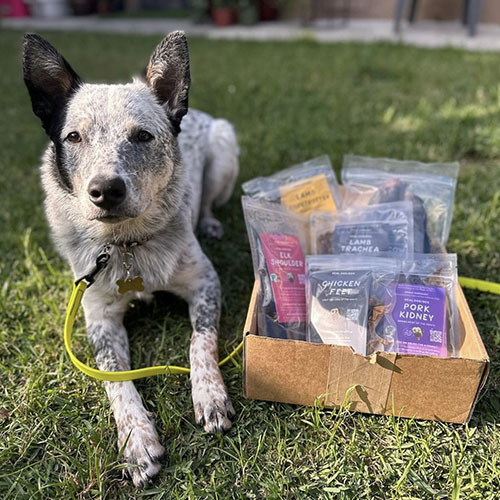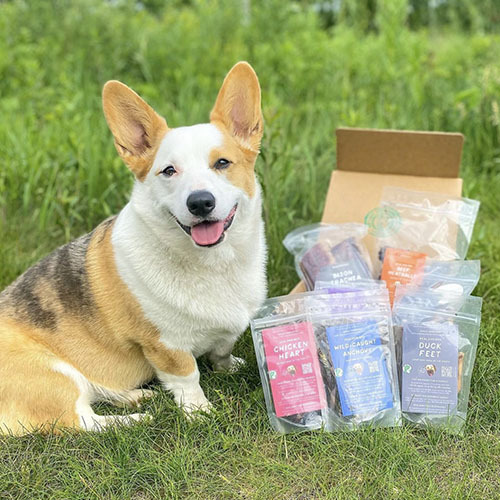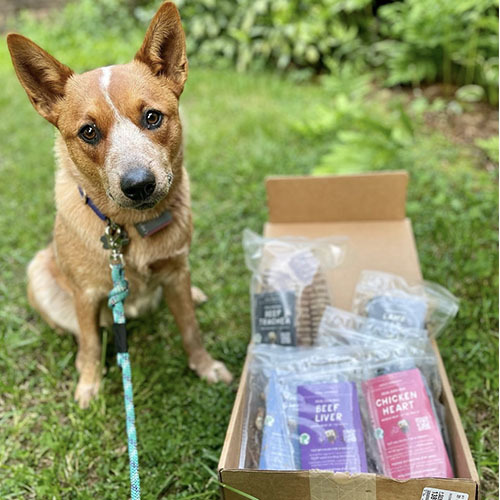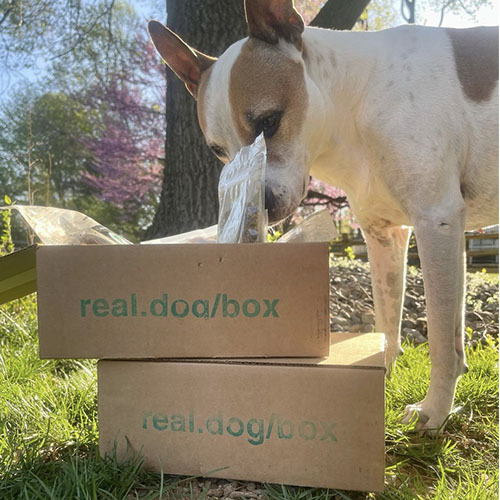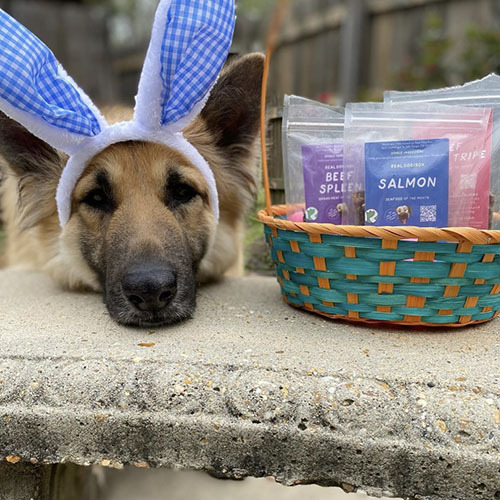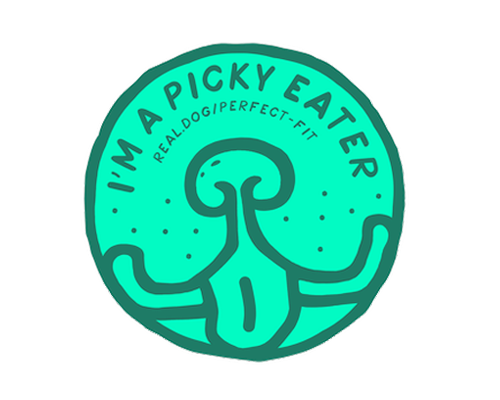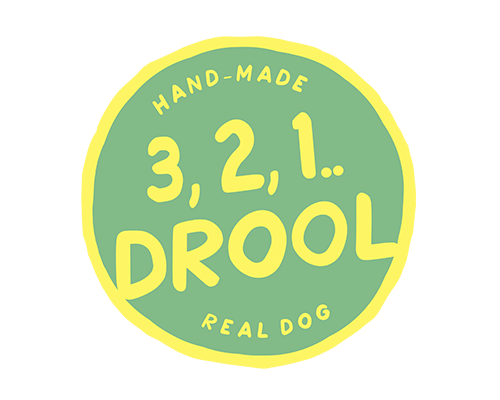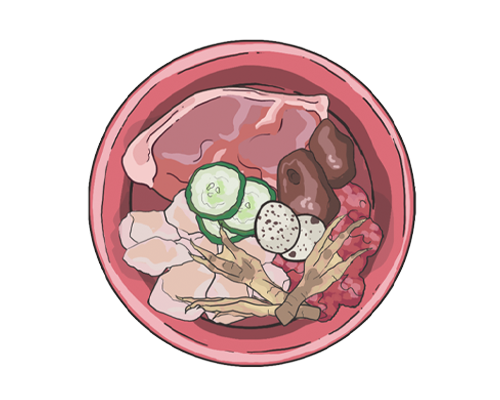 Why Real Dog Will Never Be a Human Grade Dog Food Company
Why Real Dog Will Never Be a Human Grade Dog Food CompanyTransparency and Sustainability Outweigh Human-Grade for Dog Food and Treats

Marketing versus Manufacturing
The marketing campaigns within the dog food industry are incredibly successful at convincing dog parents that kibble is healthy and nutritious. The pictures on the bag of kibble and treats depict enticing cuts of steak and chicken breasts, which humans would be willing to serve on their own plates. But research into what is truly in kibble and treats reveals an entirely different story.
Kibble companies often fail to disclose the inclusion of meat from animals not slaughtered for food purposes, also known as 4-D meats; dead, dying, diseased, and disabled, because the current laws do not require them to disclose the source of the meats used in their foods. Synthetic vitamins and minerals must be added back into the kibble because natural vitamins and minerals are lost during manufacturing. Ingredient splitting occurs to enable desirable proteins to be listed at the top of the label.
These are just a few standard marketing practices in the processed pet food world, yet none of these manufacturing processes are apparent. The three most common pet food products are dry kibble, canned, and semi-moist foods. At RDB, we have deliberately chosen to avoid all three food types because they result from the ultra-processing of ingredients that are unrecognizable, leaving consumers to diligently uncover the actual components of the food and treats they feed their beloved family members.
With all these rampant deceptive marketing practices, what should dog parents look for? What kind of questions should we be asking? Finding a company that is completely transparent in product sourcing, processing, and packing practices is ideal but often challenging. Let us walk you through some basics and show you how we choose to be transparent.

Animal Feed versus Dog Food
This is an important distinction for dog parents to be able to make. The food fed to almost all animals, other than our pet dogs and cats, is called feed, horse feed, cattle feed, chicken feed, etc. But commercial pet food companies recognize that pet owners think of their dogs and cats as family members, not just animals, so they call their products dog and cat food for marketing purposes. After all, food is what people eat!
In the past, pet food was in the same category as all other animal feeds, which is appropriate as all of the same regulations that apply to cattle and chicken feed apply to dog and cat food. However, in the 1950s, regulators decided that pet food should be a specialty animal feed product, mainly because the food was purchased to be taken into the house to feed pets rather than stored in the barn for livestock. People were concerned that animal feed was unsanitary. Hence, the commercial dog food companies changed the name to allay these fears and appease the pet owners, despite not changing any manufacturing procedures!

What is Human-Grade Pet Food?
Despite being called dog food, it is still feed-grade unless manufactured according to human-grade food regulations. Because of the logistics and costs associated with creating human-grade dog food, almost all commercial dog foods are feed-grade.
Feed grade is defined as “material that has been determined to be safe, functional, and suitable for its intended use in animal food.” The definition includes that products must be labeled appropriately per AAFCO guidelines and conform to the Federal Food, Drug, and Cosmetic Act unless an “appropriate state or federal agency” allows for different guidelines! State regulations can override federal law!
All ingredients, including supplements, must be human-edible for dog food or treats to be labeled as Human-Grade. Human-grade food must be manufactured in a facility licensed to produce human food. The facilities are routinely inspected by the USDA-Food Safety and Inspection Service (FSIS) following the Federal Meat Inspection Act (FMIA) to ensure that all food is safely handled and stored. All meat sold commercially must be inspected and passed to ensure that it is safe, wholesome, and properly labeled as human-edible.
The standards for human-grade dog food are the same for food produced for people. Human food facilities have much more stringent regulations for sanitation, personnel training, and standard operating procedures for properly handling, storing, and processing food than an animal feed manufacturing plant, which is why it is more expensive to produce human-grade food.
Companies will use other wording on the dog food labels, such as “sourced from a USDA-inspected facility,” which confuses consumers into thinking that the food is human-grade. This designation says nothing about the quality of the meat, only that it originated from a standard slaughter plant that must be USDA inspected by law.

When Human-Grade Conflicts with Species-Appropriate
The USDA has regulations defining animal carcass components as human-edible versus inedible. Inedible animal parts include the hide or skin, fur, horns, teeth, fats, bone, ligaments, tendons, cartilage, feet, glands, blood, and lungs. However, this list includes several products, such as fur, cartilage, tendons, feet, glands (ovaries, testes, and pancreas), and lungs, that are species-appropriate foods for dogs!
Should these parts be discarded into the rendering bins despite their nutritional value for dogs simply because they are not deemed edible for humans? Ironically, if sent to the rendering company, these parts will end up in commercially manufactured dog food but will have been stripped of essential nutrients due to the extreme heating processes used to create animal by-products for kibble.
So why not use these parts in a more transparent and sustainable method? If these animal parts are components of healthy animals that are butchered for human consumption, they should be considered safe to use in a species-appropriate diet for dogs. With minimal processing, such as air-drying or freeze-drying, or even when fed raw, these “inedible” animal parts are excellent additions to a dog’s meal or for treats or chews.
Currently, the USDA requires a denaturant, such as charcoal coloring, to be applied to inedible foods to prevent inedible foods from entering the human food supply chain. Inedible foods that are nutritionally sound and beneficial to dogs, such as fur and trachea, are lumped into the same category as meat from diseased and dying animals. Any food product colored with black and green dye will deter humans from eating it, but it also makes consumers uneasy about feeding it to their dogs, even if it has nutritional benefits. This confuses the average consumer and puts an undue burden on dog food manufacturers that want to use species-appropriate nutritionally beneficial foods.
We agree that 4D meats should never enter the human food or pet food supply chain unless consumers are acutely aware of the products they are in. However, some foods inedible for humans are nutritionally appropriate for dogs and should be more widely available for dog owners to feed regularly and comfortably. For manufacturers to increase the use of inedible animal parts in species-appropriate diets, the USDA must alter the practice of marking the material with green dye or a denaturing chemical like charcoal. Packing of the materials could be labeled as non-human grade or pet animal grade. But these requests cannot come from only the food manufacturers; consumers must do their part to be informed and pressure the USDA to make sustainable changes in slaughterhouse procedures.

Real Dog’s Stance on Transparency and Sustainability
You will not find a more transparent company than Real Dog Box (RDB). Our core value to “Keep it Real” is represented in every decision of our dog treats and chews manufacturing processes and service offerings. Our policies and practices are transparent in manufacturing single-ingredient treats and chews that are still recognizable as animal body parts that have been only air-dried. Individual description cards are in every package detailing the basic requirements: guaranteed analysis, calories, and feeding recommendations. We then go one step further by listing where each product was sourced and links to additional information, including how long it took to dry and other benefits and considerations.
The only item currently produced at RDB that is not a single-ingredient treat is the meatballs which consist of all six components that RDB recommends in the Real Ancestral™ diet; muscle meat, raw meaty bones, liver, another secreting organ, seafood, and fur. Again, a detailed card is inserted in every meatball package, listing every ingredient.
The only human-inedible ingredient in the meatballs is the fur from rabbits, which is an important component in meeting the fiber needs of dogs. Other food manufacturers might use pumpkin or squash ingredients to meet the fiber needs, but neither is a source that dogs naturally find in whole foods. This is why pumpkins must be processed (pureed or steamed) because the canine body cannot break it down or utilize it in its natural form.
The creation of the meatball evolved as a way to utilize extra bits and pieces from other products in our boxes to follow the Real AncestralTM diet. As a zero-waste facility, we are committed to ensuring no food goes unused. This meant we could use different items in our boxes in the right proportions to create a balanced meal replacement. Initially made for small-batch Secret Shop offerings, the meatball has become so popular as a raw food alternative that it is now available as an addition to the monthly subscription boxes!
While we are not a USDA-inspected facility or a human food facility, we are registered with the FDA, as all pet food companies should be, and licensed by the State of California's Department of Health. The FDA and the California Department of Health regularly inspect our facility and procedures.
If you follow us on social media, we regularly show the behind-the-scenes of our processes - from receiving raw material to slicing, packing, and shipping. All products are sourced from the same farms and facilities that supply food to restaurants or grocery stores for human food. Some parts, like ears and feet, are undesirable or inedible for humans but still appropriate for dogs. We regard our practices as in line with our commitment to food and farming sustainability, our core values, and our food philosophy .
In fact, we don’t just make your dog’s food; we teach you why and how to do it yourself. We are the ONLY fresh dog food company with a nutrition research arm – Feed Real Institute. Here, we teach online interactive workshops and nutrition courses to help dog parents and veterinary professionals learn more about the canine nutritional requirement and how to meet them with fresh food. Learn more about our courses.
“If I wrote a course on nutrition, this is the course I would write. It is the course I was hoping for in veterinary school and did not receive.”-Dr. Josie Beug, Specialized in Traditional Chinese Veterinary Medicine

The Promise of Variety
A fundamental value of RDB is to provide a wide variety of proteins for dogs by rotating the subscription box content monthly. Research has shown that dogs fed the same protein long-term are more prone to medical issues such as allergies, skin problems, and gastrointestinal diseases. We refuse to compromise our promise to provide variety to sell human-edible products only. Doing so would deprive dogs of many food choices and essential ingredients.
Fur is an excellent example of an inedible product that is a great source of nutrients for dogs. Fur contains high levels of manganese, an essential mineral often deficient in dogs. Studies have revealed that most dogs that have suffered from a ruptured cranial cruciate ligament, the most common joint injury in dogs, are deficient in manganese. Fur is also a great source of insoluble fiber required for a healthy gut microbiome in dogs. Undigested fur sweeps the intestinal tract free of parasites, acting as a natural dewormer.
Cartilage and tendons are natural sources of glucosamine and chondroitin, two nutrients essential for joint health in dogs. One of our most popular chews is the fur-on cow ear, which is primarily cartilage and fur, but incredibly nutritious, digestible, and appropriate for our dogs. Pancreas, deemed an inedible gland, provides digestive enzymes while ovaries and testes provide hormonal support, especially to dogs that have been spayed or neutered.
The benefits of providing these nutrients in their most natural and bioavailable state for our canine companions are reason enough for us never to want to become a human-grade dog food company. The label human-grade has little weight to it when you look at the vast array of junk food at the grocery store. Doritos® and Twinkies® are considered human-grade, yet no dog parent wants to feed them to their dog! We will stand by our research and transparency in making our product and do everything in our power to help dog parents understand this.
“We love everything about Real Dog Box. They always have the best variety and value for your money. Customer service is like no other. I can text and get a response back right away. Always helpful and very knowledgeable about their products. Each product comes packaged with its own information card that holds a wealth of feeding information on that item. Single-ingredient foods in their natural form. Real food is stinky lol! So be warned 😁 But, for my guy at least, that makes them the best treats ever!. We feed fur and love that we can always stock up on rabbit feet in the secret shop and also get chews with fur every once in a while. If you feed raw, each box offers wonderful items you can easily add to your dogs bowl at mealtime If you don't feed raw this is still a great way to add some high-value items to your dogs diet. They even offer nutritional classes to help you understand your dogs nutritional needs better. I hope to be taking a class very soon! Your subscription is super easy to change and adjust or even skip a month if you need to through the website. I can't say enough great things about Real Dog Box. I highly recommend them. 🐩💜”-Liana S., Real Dog Member
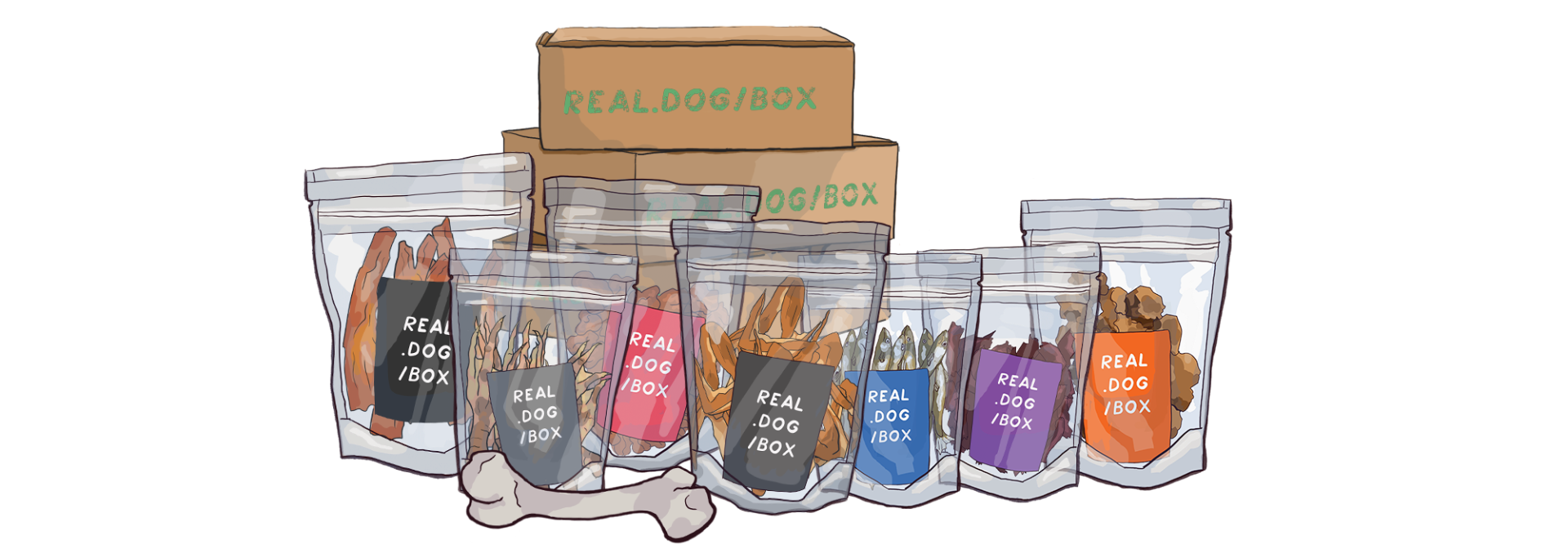
RDB Treats and Chews Made From Inedible Parts
The RDB chews provide a variety of benefits. The bull pizzles (penises) are coiled by hand and dried to provide a super chew that forces dogs to use all areas of their mouth and tooth surfaces as they chew. Lamb and pig trotters also make excellent chews that provide jaw exercises, teeth cleaning, and mental stimulation during the long chew sessions.
The only item currently produced at RDB that is not a single-ingredient treat is the meatballs which consist of all six components that RDB recommends in the Real Ancestral™ diet; muscle meat, raw meaty bones, liver, another secreting organ, seafood, and fur. Again, a detailed card is inserted in every meatball package, listing every ingredient.
Items that include hair or fur, such as cow ears, boar ears, lamb ears, rabbit ears, and rabbit feet, are great chews that contain manganese and insoluble fiber. Tracheas and aortas from lamb, beef, and bison, beef and bison backstrap, pig ear, beef tendons, and duck and turkey feet are excellent sources of glucosamine and chondroitin.
Organs such as the spleen and kidneys from beef, bison, and pork are nature’s multivitamins and mineral supplements. The inedible boney parts like the poultry wings, necks, and heads are significant for dogs’ oral health and are an excellent calcium source.
Other parts commonly thought of as organ meat, turkey gizzards, duck heart, green tripe, and bison lung are actually muscle meats that add variety to a dog’s meal. Exotic proteins, such as pheasant, camel, and alligator, are sometimes available only for the Secret Shop, as the quantity is too limited for the monthly subscription box.
Not all of the RDB treats are inedible products. Chicken feet, pork loin, elk shoulder, chicken heart, beef heart, turkey breast, chicken liver, beef liver, pork liver, pork heart, sardines, anchovies, smelt, capelin, and green-lipped mussels are all human-edible foods. They have passed the USDA inspection. However, we are not a human food facility, so these products are not labeled as human-grade.
In fact, we don’t just make your dog’s food; we teach you why and how to do it yourself. We are the ONLY fresh dog food company with a nutrition research arm – Feed Real Institute. Here, we teach online interactive workshops and nutrition courses to help dog parents and veterinary professionals learn more about the canine nutritional requirement and how to meet them with fresh food. Learn more about our courses.

Food for Thought
Before concluding that a non-human grade pet food or treat is not suitable for your dog, consider that many foods that are inedible for humans are, in fact, nutritious and appropriate for our dogs. Also, consider that much of what is deemed inedible, if not used to feed our domesticated dogs, would simply go to waste or end up in the rendering vats to be used in kibble.
We agree that dog food must have some regulatory oversight, especially regarding banning diseased meat and labeling requirements. However, the current regulations are rarely enforced and do not meet the industry's needs. As more dog parents seek more natural and sustainable ways to feed their dogs, the USDA, FDA, and other governing bodies must adjust regulations accordingly.
As companies look to become more sustainable and reduce their carbon footprint, finding uses for undesirable animal parts needs to be examined. Although slaughterhouses can discard inedible animal parts into a bin designated for rendering, with proper handling, many of those parts are sold to companies to use as species-appropriate dog food components. It is okay for canine-appropriate food not to be human-appropriate. Every species has its own nutritional requirements!
The USDA could create a new designation, such as dog-edible or pet edible, to accommodate the use of parts edible by dogs or other pet animals. With a new designation, the stigma of inedible would be removed. Simple solution, but very unlikely.

Asking the Right Questions
While "human-grade" may seem to be the gold standard, we should ask manufacturers more relevant questions now that there are raw foods comprised of visibly identifiable components.
- Why were those ingredients chosen?
- Are the ingredients in the food biologically appropriate for my dog?
- Where were the ingredients sourced; locally, regionally, or globally?
- How was the food made, specifically to what temperatures were the ingredients exposed?
- Why was it ground to the point that no ingredient is identifiable?
- Can I tour your facility and see your manufacturing process?
Now that so much canine nutritional information is readily available to dog parents, we must take the time to understand our dogs’ nutritional requirements. We can no longer blindly trust the big kibble companies or even our veterinarians to provide the correct information. It is our responsibility to make the best choices for our dogs.
When researching dog food companies, the most critical attribute to find is transparency. If a company refuses to reveal a complete ingredient list (including preservatives), sourcing of the ingredients (including synthetic vitamin and mineral pre-mixes), or manufacturing processes, they are not being forthright. At Real Dog Box, we pride ourselves on being fully transparent and allowing our customers to ask us about all aspects of our company and our practices!
Every person on our Member Service team is a Certified Professional Canine Nutritionist . You can reach our team anytime at help@real.dog or text 858-348-5954.
References
Organic, Humanely Raised, Fresh, Raw and Human Grade – One Does not Guarantee the Other
Summary of Federal Inspection Requirements for Meat Products
Where's the (Not) Meat? Byproducts From Beef and Pork Production
FSMA Final Rule for Preventive Controls for Animal Food | FDA
eCFR :: 21 CFR Part 589 -- Substances Prohibited from Use in Animal Food or Feed
It's an investment for your dog's life.
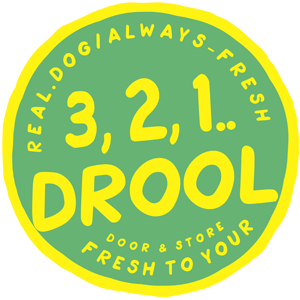 We craft our food in small batches, air-dry it in one single step, and deliver it fresh.
We craft our food in small batches, air-dry it in one single step, and deliver it fresh.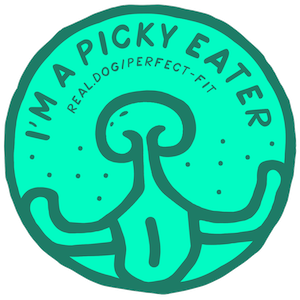 We guarantee that if your dog doesn’t love a treat, we’ll replace it for free.
We guarantee that if your dog doesn’t love a treat, we’ll replace it for free.